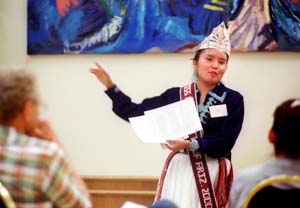|
|
Few Among Many
by Carmen Duarte Arizona Daily Star
photo by Ben Kirkby/Staff
Sherrie Stanley, Miss Native America - University of Arizona 2000, addresses a group of incoming freshmen
|
"They always pushed me to go on in my education so I could teach the little children," said the 18-year-old civil engineering major. The freshman moved this week to the University of Arizona from Kayenta in Northern Arizona. She knows eyes will be on her at the university - watching her performance and integration into college life. American Indian enrollment at the UA remains tiny, at 2 percent of the student body, despite a special dormitory wing, scholarships and a student center. Tsosie is among fewer than 800 Indian students at the UA. Precise fall enrollment is not yet known, but last year 755 Indian students attended. Both Arizona State and Northern Arizona universities attract more Indian students, with 1,300 (6.5 percent) at NAU and 900 (2 percent) at ASU last year. But according to Rick Kroc, UA director of assessment and enrollment research, the percentage of Indian students at the university has grown from less than 1 percent in 1983. Retention also has improved, but not enough, he says:
By contrast, the persistence rate for white students runs about 77 percent, Kroc said. Karen Francis-Begay, who was named director of Native American Student Affairs last month, said her staff will continue helping students to not feel isolated on campus. "We want students to feel connected with their peers," said Francis-Begay, whose office offers students a center where they can share a study room and computer lab and participate in social activities. In 1994, the university opened the O'odham Kí, or The People's House, a wing for Indian students in the Graham-Greenlee Residence Hall. The goal was to make students feel more at home. Tsosie said she thought about making the O'odham Kí her home, but opted instead for the Arizona-Sonora honors dorm. The O'odham Kí holds 34 students, but this year 12 Indian students are sharing the wing with non-Indian students. "A lot of our students rely on tribal funding, and they did not know this year whether they received monies to come to school," Francis-Begay said. "The tribal funding time line was not in sync with the university's time line." No study has been done to show whether the wing, which is optional to students, has helped retain Indians at the university, Francis-Begay said. She said a study will begin this year. "We really have to get on the ball and get the research done," she said. The majority of the UA's Indian students are Navajo, followed by Tohono O'odham. Hopi rank third, followed by Cherokee, White Mountain Apache and Pascua Yaqui. Francis-Begay said the UA has to do more to recruit Indian students who are attending community colleges but not transferring to the state's universities. "Many students wait two or three years (to transfer), and it's primarily for financial reasons. They have to work," she said. "We have to let students know the types of financial aid available and work closer with community college representatives. We need to have a stronger presence at the college fairs and invite community college students to our campus. We need more faculty to serve as role models," she said. Sherrie Stanley, Miss Native America - University of Arizona 2000, established a mentoring program for freshmen. Stanley, a civil engineering student who plans to graduate this December, is a member of the American Indian Science and Engineering Society, and the mentoring program is through that group. "There are no mentors for freshmen, and they are the ones that need it the most," said Stanley. "Mentors can help students have a personal connection to the UA." Stanley said she also wants to find more tutors for freshmen. Tsosie agreed that mentors and tutors can help freshmen, not only with homework but by offering friendship. In her case, however, family support is the biggest help. Tsosie is the third child in her family attending college. Both her parents are teachers. She wants to make a difference. Once she graduates as a civil engineer, she plans to return home and use her degree to better the Navajo Nation. "We need to protect our land and take care of our environment," she said. "My grandparents told me to pursue my dreams and that anything is possible," said Tsosie. "More of our youth have to graduate from high school and pursue their dreams." |
|
|
| Canku Ota is a free Newsletter celebrating Native America, its traditions and accomplishments . We do not provide subscriber or visitor names to anyone. Some articles presented in Canku Ota may contain copyright material. We have received appropriate permissions for republishing any articles. Material appearing here is distributed without profit or monetary gain to those who have expressed an interest. This is in accordance with Title 17 U.S.C. section 107. |
|
Canku Ota is a copyright of Vicki Lockard and Paul Barry. |
|
 As she
moved from the Navajo Reservation to join 35,000 UA students starting fall classes this week, JoLene Tsosie was
filled with inspiration from her grandparents.
As she
moved from the Navajo Reservation to join 35,000 UA students starting fall classes this week, JoLene Tsosie was
filled with inspiration from her grandparents.